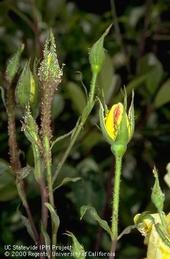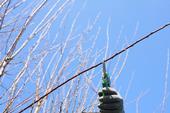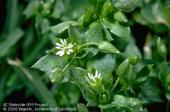
Are you surprised to see aphids on some of your plants this time of year? With the current mild temperatures in California, aphids may continue living and reproducing in some locations this winter, with female adults giving birth to live young every day.
Low to moderate numbers of aphids aren't usually damaging, but allowing them to continue reproducing on your plants may mean more aphids this spring. Once aphid populations explode in spring, their feeding can turn leaves yellow and stunt shoots on certain plants. Aphids can also produce a great deal of honeydew, a sticky byproduct of their feeding.
For information on how to manage aphids in many situations, consult the

Winter is an ideal time to prune deciduous fruit and shade trees, since the trees are dormant and you can more easily see the tree canopy. In many cases, pruning can also help prevent or control certain insect and disease problems.
For help with pruning, visit the UC IPM web page called Pruning fruit and shade trees and shrubs.This page provides links to plant-specific pruning information for fruit trees, nut trees, landscape trees, and others. You can also find links to diseases and environmental disorders that commonly affect fruit and shade trees, as well as additional information on the topics of landscape management and videos on...

Weeds can be a real nuisance in gardens and landscapes, and even during the colder winter months, some kinds of weeds continue to grow and thrive. These are called winter annual weeds.
Most weeds are classified as annuals, biennials, or perennials. Annuals complete their life cycle (germinate from seed, grow, flower, set seed, and die) in one year or less, biennials generally complete their life cycle in 2 years, and perennials live longer than 2 years.
Examples of winter annual weeds include chickweed, little mallow, and annual bluegrass. They germinate and actively grow during fall and winter, then produce seed and die by the hot summer months.
If allowed to set seed, annual winter weeds can continue to grow...
![Catchweed bedstraw. [K. Windbiel-Rojas]](https://ucanr.edu/blogs/UCIPMurbanpests/blogfiles/42858small.jpg)
Catchweed bedstraw. It's that weed that tugs at your clothes while you pass by or attaches to your dog or cat's fur. It's also known as the “Velcro plant” since it easily clings to anything that touches it.
In the garden, catchweed bedstraw competes with landscape plants for nutrients, water and light. Once mature, it can reach 6 feet long and be problematic when it smothers desirable plants. It can also make it difficult for gardeners to harvest produce.
Catchweed bedstraw is a winter or summer annual in California. The best control is to physically remove it as soon as it appears so it does not spread. For tips on how to manage this weed in your landscape, please visit the
- Author: Anne Schellman
- Author: Karey Windbiel-Rojas
![Pruning out an scale insect infestation. [Photo by C. Reynolds]](https://ucanr.edu/blogs/UCIPMurbanpests/blogfiles/40504small.jpg)
Now is the time to prepare your garden and landscape for winter. The simple tasks recommended below will help prevent perennial weeds, insect pests, and certain disease pathogens so these problems don't get established and become difficult later.
Weeds
- Manage weeds using nonchemical methods such as cultivation, handweeding, or mowing.
- Prevent weeds using competitive plants, mulches, and hand removal.
- Herbicides (weed killers) are rarely needed in established landscape plantings when nonchemical controls are used regularly.
To learn more about managing weeds, see the UC IPM Pest Note: Weed...


